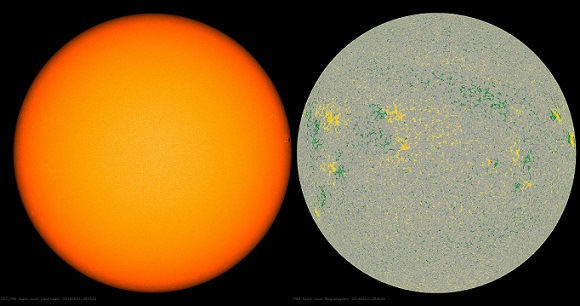

| Online: | |
| Visits: | |
| Stories: |

| Story Views | |
| Now: | |
| Last Hour: | |
| Last 24 Hours: | |
| Total: | |
Blank Sun Goes Eerily Quiet, Almost No Sunspots seen, X-ray Output flatlines / Solar Update (+Video)
The Sun Goes Blank In Weakest Solar Cycle In Century
The sun is almost completely blank. The main driver of all weather and climate, the entity which occupies 99.86% of all of the mass in our solar system, the great ball of fire in the sky has gone quiet again during what is likely to be the weakest sunspot cycle in more than a century. The sun’s X-ray output has flatlined in recent days and NOAA forecasters estimate a scant 1% chance of strong flares in the next 48 hours.
Not since cycle 14 peaked in February 1906 has there been a solar cycle with fewer sunspots. We are currently more than seven years into Solar Cycle 24 and the current nearly blank sun may signal the end of the solar maximum phase. Solar cycle 24 began after an unusually deep solar minimum that lasted from 2007 to 2009 which included more spotless days on the sun compared to any minimum in almost a century.
However, while a weak solar cycle does suggest strong solar storms will occur less often than during stronger and more active cycles, it does not rule them out entirely. In fact, the famous “superstorm” Carrington Event of 1859 occurred during a weak solar cycle.
In addition, there is some evidence that most large events such as strong solar flares and significant geomagnetic storms tend to occur in the declining phase of the solar cycle. In other words, there is still a chance for significant solar activity in the months and years ahead.
Clearly even a weak solar cycle can produce a very strong storm.
We need to be prepared!
SOLAR UPDATE JUNE 2, 2016
A filament eruption was observed towards the northeast limb on Wednesday evening but is not likely to impact our planet.
A middle latitude coronal hole was observed on Wednesday. This zone will turn into a geoeffective position by as early as this weekend and an increased solar wind stream could provide a period of enhanced geomagnetic activity at higher Earth latitudes.
http://www.solarham.net/
This coronal hole has been here before, on May 8th (Mother’s Day), when it sparked the strongest geomagnetic storm of 2016.
Coronal holes are places in the sun’s atmosphere where the sun’s magnetic field opens up and allows solar wind to escape.
http://spaceweather.com/
Clips, images credit: ESO, ESA/HUBBLE, SDO & NASA

Images credit: SDO


